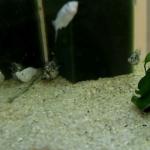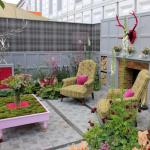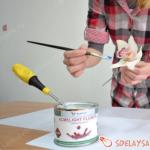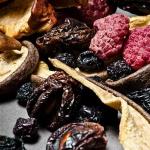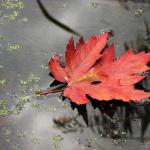How to deal with spots on anthurium leaves
When the anthurium is healthy, its foliage has a smooth surface, the color characteristic of the variety without traces of yellowness or dried spots. The leaves are quickly renewed, and reappearing without difficulty and damage unfold. This can be achieved by creating the conditions necessary for the growth of anthurium and providing it with competent regular care.
Possible causes of drying and spots on anthurium leaves
Flower growers who know the characteristics of a flower consider anthurium to be a very unpretentious and grateful indoor plant. And yet, lovers of this culture sometimes have to face some problems, most often related to:
- with errors in the organization of irrigation;
- in violation of the feeding schedule;
- with excessive dryness of the air;
- with improper plant lighting.
A little less often, anthurium leaves and he himself suffer from sudden changes in temperature and keeping the flower in a cold room.
 As a result of a prolonged violation of the conditions of maintenance and care, plants are at risk of being affected by rot and fungal diseases that threaten, if urgent measures are not taken, the death of the pot culture.
As a result of a prolonged violation of the conditions of maintenance and care, plants are at risk of being affected by rot and fungal diseases that threaten, if urgent measures are not taken, the death of the pot culture.
Anthuriums can be attacked by harmful insects that harm both the root system of the culture and its aerial parts.
So why do anthurium leaves turn yellow? And why do brown spots appear on the leaves?
aging anthurium leaves
 As with other plants, anthurium leaves may turn yellow for a completely natural reason, due to old age. In such cases, the inevitable processes, first of all, affect the foliage located closer to the ground.
As with other plants, anthurium leaves may turn yellow for a completely natural reason, due to old age. In such cases, the inevitable processes, first of all, affect the foliage located closer to the ground.
Yellowness, spreading from the edges of the leaf plate, gradually covers it completely, the leaf loses its elasticity and juiciness, and then turns brown. If it is not removed, such an anthurium sheet dries and falls off on its own. If the plant is kept in proper conditions, then the fall of old leaves does not cause damage to the anthurium, because at the same time new healthy foliage actively appears at the top of the stem.
Since the process is natural and inevitable, you should not worry about it. However, flower growers often have a question: “Do I need to remove yellowed or dry anthurium leaves?”
Obviously, such leaf plates no longer fulfill their main function, but the plant spends certain forces on their maintenance. Therefore, it is better to cut off the leaves that have become obsolete, making life easier for the whole plant and making it more attractive.
 To prevent the cut from becoming a site for the spread of infection, it is useful to treat the cutting tool, be it scissors or a knife, with alcohol, and sprinkle the damaged tissue on the anthurium with crushed charcoal.
To prevent the cut from becoming a site for the spread of infection, it is useful to treat the cutting tool, be it scissors or a knife, with alcohol, and sprinkle the damaged tissue on the anthurium with crushed charcoal.
If the leaf is still juicy, do not tear it off by hand, because this can seriously injure the stem.
In addition to the natural reasons why anthurium leaves become stained or dry, flower growers have to deal with the consequences of the mistakes they made when caring for a houseplant.
Spots on anthurium leaves due to excess or lack of light
 The condition of the plant is strongly influenced by its location. Although in the tropics, where anthuriums are used to living in nature, there is no shortage of sunlight, it is more comfortable for plants to be in partial shade.
The condition of the plant is strongly influenced by its location. Although in the tropics, where anthuriums are used to living in nature, there is no shortage of sunlight, it is more comfortable for plants to be in partial shade.
The appearance of spots on the leaves of anthurium, the grower may be due to direct sunlight that burns the leaf plates. It is impossible to avoid deterioration in the appearance of a green pet if the anthurium is in a rather dark place and suffers from insufficient lighting.
If the plant has stopped growing, blooms little and reluctantly, it probably does not have enough light. Anthuriums with dense dark green leaf blades suffer especially from this. Under conditions of short daylight hours or, being constantly in the shade, the cuttings of the anthurium leaves lengthen, the leaf plates become smaller and noticeably turn pale. By rearranging the plant on a well-lit window sill, you can see how it regains its former beauty, the development of yellowness and spots on the leaves of the anthurium stops.
The main thing, in an effort to provide the plant with the required lighting, is not to overdo it and prevent sunburn.
When the pot is under the direct rays of the sun, flower growers are interested in what to do, because the leaves of the anthurium turn yellow or acquire a bronze “tan”.
A good effect is given by glass tinting with a special film that reflects part of the solar radiation. If it is not possible to equip the window in this way, the plant can be moved from the glass, or during the hours when the sun is most active, any impromptu screen can be placed near the anthurium.
If urgent measures are not taken, an excess of sun appears not only on the color of the foliage, but also on its health. This includes brown spots appearing on the tips of the anthurium leaves, and the loss of affected foliage.
Excessive dryness of the air - the cause of dry anthurium leaves
 Similar symptoms can be seen in anthurium, which is in a room with dry air. Most often, this reason makes itself felt at the beginning of the heating period, when the usual conditions for the plant change, and aerial roots and foliage can no longer get the required amount of moisture from the air.
Similar symptoms can be seen in anthurium, which is in a room with dry air. Most often, this reason makes itself felt at the beginning of the heating period, when the usual conditions for the plant change, and aerial roots and foliage can no longer get the required amount of moisture from the air.
Why do anthurium leaves turn yellow in this case? They just don't get enough food. Yellowness spreads from the edges of the leaf plates to the center, then the tissue at the tips and edges of the anthurium leaves dries. Young leaves developing in dry air often fail to unfold properly and are deformed or damaged.
 You can’t do without additional air humidification, and you can achieve the required humidity of about 70–85% by anthurium using a household humidifier, as well as improvised means. The plant responds well if the pallet is covered with fine expanded clay and filled with water. The pot is placed on the filler so that the roots do not have contact with moisture.
You can’t do without additional air humidification, and you can achieve the required humidity of about 70–85% by anthurium using a household humidifier, as well as improvised means. The plant responds well if the pallet is covered with fine expanded clay and filled with water. The pot is placed on the filler so that the roots do not have contact with moisture.
Do not forget that a change in temperature and light conditions necessarily leads to the fact that the soil dries out faster or slower, and the mode of moisture consumption also changes in the plant.
This means that the schedule will have to change. It is the improper moistening of the soil under the houseplant that most often provokes the formation of brown spots, dry patches and yellowness on the leaves of the anthurium.
Anthurium leaves dry in spots - the reason is watering
The leaves are the first to react to the violation of watering and the problems caused by this. If at anthurium on the leaves brown spots, this may be caused by moisture on the leaf blades. In the sun, such drops act as lenses and literally burn through living tissue.
 It is even worse if the plant has been exposed to a humid environment for a long time. In this case, tissue necrosis does not develop in spots on anthurium leaves, but, starting from the edges, spreads to the entire platinum sheet. The soil in the pot of such an anthurium should be tried to dry, and with its increased density, which provokes the accumulation of moisture, change the entire soil.
It is even worse if the plant has been exposed to a humid environment for a long time. In this case, tissue necrosis does not develop in spots on anthurium leaves, but, starting from the edges, spreads to the entire platinum sheet. The soil in the pot of such an anthurium should be tried to dry, and with its increased density, which provokes the accumulation of moisture, change the entire soil.
During transplantation, be sure to examine the root system of the plant and remove all roots that are susceptible to decay.
For a plant that lives in a cool room, a violation of the irrigation regime also threatens fungal diseases.
Dry spots on anthurium leaves - the result of the activity of fungi
 Like root rot, the spread of harmful fungi will certainly cause anthurium leaves to dry in spots. At the initial stage of the disease, small yellow spots of round or irregular shape can be seen on the leaf plates, which gradually expand, become brown in the center and begin to dry. The tissue at the site of the stain undergoes necrosis and may crumble, and concentric dark circles become visible around.
Like root rot, the spread of harmful fungi will certainly cause anthurium leaves to dry in spots. At the initial stage of the disease, small yellow spots of round or irregular shape can be seen on the leaf plates, which gradually expand, become brown in the center and begin to dry. The tissue at the site of the stain undergoes necrosis and may crumble, and concentric dark circles become visible around.
Brown spots on the leaves of anthurium are not the only symptom of the disease. Fungi and putrefactive microorganisms cause the main damage to the root system.
Therefore, when similar spots appear, the anthurium must be carefully removed from the pot and the roots examined. If the roots of the plant have changed from a white or light cream color to a brown or black tint, their tissues have become soft and slimy - this is a clear sign of root rot. This plant needs:
- remove the remains of the substrate;
- cut disease-damaged and dry anthurium leaves;
- cut off all damaged roots to a healthy white tissue;
- process slices with crushed coal;
- and the whole plant fungicide.
After that, the anthurium is transplanted into a new soil, previously, like a pot that has been disinfected.
 The new substrate should be loose so that any excess water leaves the soil easily and does not harm the roots. After moistening the soil, the drained liquid must be removed from the pan, and until the next watering, they wait until the surface of the earth under the plant dries out.
The new substrate should be loose so that any excess water leaves the soil easily and does not harm the roots. After moistening the soil, the drained liquid must be removed from the pan, and until the next watering, they wait until the surface of the earth under the plant dries out.
It is important to remember that only settled warm water at room temperature is taken for watering anthuriums.
Deficiency and excess nutrition of anthurium
 If the plant has stunted growth, and its young leaves are smaller than the ones that opened earlier, the anthurium is probably suffering from a nutritional deficiency. The lack of basic elements, for example, phosphorus or potassium, leads to the fact that the leaves of anthurium turn brown. A similar effect can be expected if the substrate lacks calcium or magnesium.
If the plant has stunted growth, and its young leaves are smaller than the ones that opened earlier, the anthurium is probably suffering from a nutritional deficiency. The lack of basic elements, for example, phosphorus or potassium, leads to the fact that the leaves of anthurium turn brown. A similar effect can be expected if the substrate lacks calcium or magnesium.
For feeding anthuriums, liquid ready-made products are used, which are used weekly to restore a damaged plant, using a 25 percent concentration of that recommended by the manufacturer. When the pet gains strength, you need to fertilize it every two weeks.
Sometimes not only a lack, but also an excess of fertilizer causes the development of yellow and brown spots on anthurium leaves. In case of an overdose of top dressing, it is better to transplant the plant into a new soil, after washing the root system.
Pests on anthurium leaves
Shchitovka, all kinds of mites, aphids and mealybugs are the insects that most often cause damage to indoor anthuriums .
 And asking why the leaves of anthurium turn yellow, flower growers should carefully examine the stem of the plant, paying attention to the area near the ground, leaf petioles, their leaf blades and sinuses.
And asking why the leaves of anthurium turn yellow, flower growers should carefully examine the stem of the plant, paying attention to the area near the ground, leaf petioles, their leaf blades and sinuses.
At the first sign of insects, the anthurium is treated with ready-made complex insecticides or a soap solution, to which 1 gram of nicotine sulfate is added per liter of water. Since insect control agents are toxic, a day after treatment, the plant is washed with clean water, protecting the soil from excessive moisture.
How to care for anthurium - video
